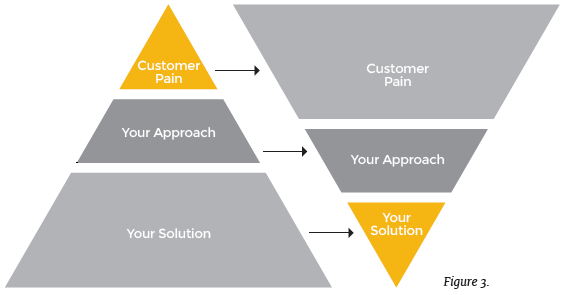I feel your pain.
This phrase, which quickly became a punch line in late-night television monologues after it was delivered by then-presidential candidate Bill Clinton, still finds occasional use today.
Used to express empathy, or more precisely, the “intellectual identification with or vicarious experiencing of the feelings,thoughts or attitudes of another,”(1) it may soon be finding application in a very different context — the branding world. Specifically, I would argue that “Brand Empathy” is the next logical step in the evolution of business-to- business (B2B) brands.
In order to explain this idea, it is necessary to go back a few years — remarkably few — and take a closer look at the role of brands in the B2B selling environment.
Courtship before marriage
B2B sales have always been thought of primarily as “considered purchases” — that is, often complex, high- ticket, high-risk offerings (e.g., enterprise software or jet engines) that are purchased only after great scrutiny. The behavior of both buyers and sellers is significantly different in the B2B sales environment. This is especially true in three areas:
- Longer sales cycle
B2B sales typically require an extended decision- making process. On the seller side, this has led to the strategy of “courtship before marriage,” in which communication efforts start well before a sale is consummated as prospects pass through various stages of buying readiness on their way to becoming customers. - Multiple decision makers
B2B purchases are typically made by teams composed of individuals with different job titles and/or functional areas of expertise. This means different levels of influence and needs often have to be taken into account in communication efforts – what is important to engineering management may not be as important to procurement and vice versa. - Educated buyers
B2B buyers do extensive research – today, mostly online – before they purchase. Brands have tried to take advantage of this with communication strategies that meet the information needs of the buying team at the most important points in the process.
Companies have historically taken the approach that it is the role of branding to create awareness of and preference for a company’s products/services in the evaluation and recommendation stages, since that is where efforts were likely to have the greatest influence (Figure 1).

Enter “Online Dating”
Over half the buying process is completed before a buyer ever engages with a vendor or a sales rep.

51% of tech buyers said they are influenced by at least one social network when considering business purchases.
To no one’s surprise, the Internet has impacted this process in no small way. For years, it was the job of the B2B buyer to weigh the merits of competing brand claims, tolerating whatever bias was inherent in these claims. Google, blogs, Twitter and discussion forums have turned this process on its head. Today, it is the job of the buyer to compare product/service information (often based on first-hand experiences) published by disinterested third parties (often industry peers) against brand claims. In fact, a recent study shows that 51% of tech buyers said they are influenced by at least one social network when considering business purchases. Since there is a perceived lack of bias in this “socialized” information, there has been an understandable loss of brand influence at stages of the process where it once was considerable. Like in online dating, a brand can now be eliminated before it has had a chance to even knock on the door with bouquet in hand. In fact, according to one study, more than 50% of the buying process is completed before a buyer ever engages with a vendor or a sales rep.
A new “white space”
Is branding less important now as a result of these changes? Not by a long shot. A loss of influence in one part of the process can be more than offset by gaining influence in another, formerly neglected part: Engaging buyers before they fully enter the buying process.
Think about it. B2B buyers are first out to solve a problem or fulfill an unmet business need – not to buy a product or service. This type of thinking usually starts a long time (months? years?) before vendor evaluation begins. What if your brand could get in early, at a stage where its influence may be much higher than you ever expected? The secret to doing this is creating “Brand Empathy” – the perception that your company deeply understands and cares about a prospect’s business, its challenges/needs and the marketplace in which it operates — in a way that creates a more favorable environment for your brand downstream.
Brand empathy:
The perception that your company and cares about a prospect’s business, its challenges/needs and the marketplace in which it operates
Why is this such an important strategy? Three reasons:
- If you can frame the debate about a problem, and generate conversations around solving it, you can strongly influence your prospects’ thinking about doing so. At the end of the day, companies don’t really buy your product or service (your competitors have those, too!) – they buy into your approach to solving their problems.
- If you can align your approach with the problem prior to the review of other approaches, you can make your brand the “marker” by which others are measured. This is clearly a superior position to be in – first-in-mind when you and your competitors enter the “gauntlet” stages of the buying process.
- Demonstrating that you understand prospect problems/needs shows that you listen, that you can put yourself in their shoes. Even when purchase decisions get highly complex and expensive, buyers want to feel good about the brand they choose. B2B sales have always had an emotional component to them, as well as a rational one.
Most B2B customers know all too well what ails them. They’re just suspect of the cure – too many different doctors handing out prescriptions without taking note of symptoms! Brand Empathy is about reversing this order to the benefit of your brand.
Establishing empathy
In Wired to Care: How Companies Prosper When They Create Widespread Empathy, business strategist Dev Patnaik provides a number of cases of how great companies around the world benefit from building a culture of empathy for the people they serve. One example he cited was IBM. When Lou Gerstner became CEO in the 1990s, the company was in a state of serious decline. One of the measures he took to turn things around was “Operation Bear Hug,” a program that involved sending out Big Blue’s top managers to meet personally with customers. They were instructed not to try to sell anything at these meetings, but instead, to listen to customer challenges and then to think about how IBM might help.
Operation Bear Hug was essentially an attempt to change the culture of a company known at that time more for its arrogance than its empathy. By the author’s account, it worked:
Managers discovered that large corporate clients were fascinated by the Internet, but unclear about what they should do about it. Beyond selling product, IBM realized that it could make a major impact by providing the infrastructure needed to help large enterprises leverage the power of the Web. The resulting e-business initiative was wildly successful and helped put IBM on the path to long-term growth.
In Patnaik’s view, when people inside a company develop a shared sense of what’s going on with their customers, it can serve as a powerful driver for business growth – as in the case of IBM discovering new opportunities for innovation. By making empathy an aspect of brand strategy, however, companies can leverage this dynamic externally in ways that will also lead to economic benefit by creating a more favorable perception of a company in the minds of its customers and prospects early in the purchase process (figure 2).

Linking empathy to your approach
Even if the marketplace believes your company empathizes with its challenges, you’re only halfway there. The next hurdle is to convince buyers that your way of attacking their problems is superior to that of your competitors. If your customers and prospects are philosophically aligned with your approach, approving a P.O. for the purchase of your solution will not lag far behind.
vAuto, a company that markets inventory management software to automotive dealerships, has been very successful in employing this strategy. The company has displayed a profound understanding of a problem automobile dealers across the country face – the Internet hurting their used car business by giving consumers price transparency in their local market. Instead of just acknowledging this problem and marketing its software as a “better mousetrap” (as its competitors do), vAuto sells a philosophy – Velocity Management. This philosophy is based on three core principles:
- Live market data on used vehicle sales trumps historical market data
- Used vehicle inventory creates greater ROI the faster it turns (velocity)
- An auto dealer’s online presence is more important than its physical presence
According to vAuto, successful implementation of its approach can transform dealerships into operations that will thrive in today’s used car marketplace. Naturally, vAuto’s software delivers everything a dealer needs to implement its approach, but that’s almost besides the point – once a dealership buys into its Velocity philosophy, the rest is a fait accompli.
A rose by another name?
Brand Empathy shares some characteristics with what has been known for years as “thought leadership marketing.” Take this definition by Gartner:
Thought leadership centers on earning trust and credibility. Thought leaders get noticed by offering something different – information, insights and ideas, for instance. Thought leadership positions you and your company as an industry authority, resource and trusted advisor by establishing your reputation as a generous contributor to your industry.**
Thought leadership, however, has a somewhat different goal than Brand Empathy: To position a company as an industry visionary whose opinions become highly respected and sought after. While this is a worthwhile objective to be sure, Brand Empathy is about earning customer trust through a shared recognition of their problems. In other words, it is achieved not by first showcasing your expertise, but by listening and then engaging in conversations that are far bigger. It’s about convincing customers and prospects you care about what they are up against, not just how smart you are.
One of Movéo’s clients, Westex, is a manufacturer of flame resistant fabric sold to garment manufacturers. The protective clothing made by Westex’s customers is worn by electrical workers at risk of serious injury or death if involved in arc flash explosions. One of the important issues surrounding the use of flame resistant clothing is compliance – many workers won’t wear it because they mistakenly believe it to be uncomfortable or even unnecessary. Battling this perception is paramount for garment makers, and not only for the human toll involved – if such clothing is not used, it is often not bought.
For years, Westex has hosted live arc flash demonstrations and educational seminars attended primarily by companies with employees at risk. This unique annual event – put on free of charge, but produced at considerable expense by Westex at an independent testing facility – is intended to promote greater understanding of arc flash hazards in the hope that companies will better be able to educate their workers.
 While Westex obviously benefits if, down the road, one of these companies purchases garments made of its fabrics, the event is not about ringing the cash register. It’s about showing empathy about a serious and still-prevalent industry problem. As a result of this and other activities, the Westex brand is perceived as a highly trusted thought leader on the topic – across the entire sales channel, as well as in standards bodies. However, it is also perceived as a brand that cares enough to put “its money where its mouth is.”
While Westex obviously benefits if, down the road, one of these companies purchases garments made of its fabrics, the event is not about ringing the cash register. It’s about showing empathy about a serious and still-prevalent industry problem. As a result of this and other activities, the Westex brand is perceived as a highly trusted thought leader on the topic – across the entire sales channel, as well as in standards bodies. However, it is also perceived as a brand that cares enough to put “its money where its mouth is.”
Caveat venditor: Before you start restructuring your brand and marketing program to take advantage of this paradigm, here are a few words of advice:
Brand empathy cannot be bought While you can attempt to influence perceptions through the use of tools and tactics, it is ultimately your prospects and customers who grant you “empathy status.” You need to sincerely wrap your head around their problems and needs before you go to market. This may take research or (gasp!) actually listening to the sales force, who hears about customer problems every day.
Brand empathy should not be sold A recent post on the Harvard Business Review Blog talks about “gift economies” – ones where value is not determined by supply and demand, but from the relationship between the giver and receiver and its meaning in the community.(3) Taking that as a cue, demonstrating Brand Empathy should not involve a financial transaction. By giving away something for nothing – valued thought leadership, for instance – you build trust. Yes, you can ask for their contact information, just not their money.
Brand empathy does not mean brand apathy For the foreseeable future, B2B marketing will continue to involve a mix of compelling content that is aligned with all parts of the buying process. Just because the influence of this content may not be what it once was in certain stages does not mean it is not needed or valued anymore by anyone.
Here are a series of other practical steps you can take to introduce Brand Empathy into your program:
Try your own version of “Operation Bear Hug.” Remember not to try to sell anything at these customer meetings – other than the fact that your company cares enough to sit back and listen.
Acknowledge your customers’ challenges consistently — don’t write a single white paper or blog post and check Brand Empathy off your “to do” list.
Review your content strategy. Today, how much of it is about your solution vs. customer pain and your approach to solving it? Try “inverting the pyramid” (Figure 3).
Be down-to-earth and authentic in communications — customers and prospects can spot a phony a mile away.
Get the sales force on board. Introducing customer pain/need early in a presentation has long been recommended by experts on persuasion (e.g., Monroe’s Motivated Sequence).
Be confident in your solution, but don’t be a know-it-all. It’s OK to acknowledge there may be other approaches out there, just explain why your company took the path it did.
Monitor social media. If customer problems are being talked about as you would talk about them, your efforts may be paying off.
“Bring it back to them.” The moves your company makes – a new product, an acquisition, a new CEO – should always be somehow traceable to your customers’ best interests.
Before presenting your solution, never assume everyone is operating from the same point of reference or knowledge base.
Look for opportunities to be collaborative. Offer to test, learn and solve things with your customers – not just for them.
Inverting the content pyramid
 In the future, exhibiting Brand Empathy will become an increasingly important way for B2B brands to earn business. Does creating it have to be a monumental task? For companies that have already taken the time to appreciate the world through the prism of their customers, perhaps not. For other companies, it very well might be. To the latter, all I can say is “I feel your pain.”
In the future, exhibiting Brand Empathy will become an increasingly important way for B2B brands to earn business. Does creating it have to be a monumental task? For companies that have already taken the time to appreciate the world through the prism of their customers, perhaps not. For other companies, it very well might be. To the latter, all I can say is “I feel your pain.”
- dictionary.com
- “ITPurchasingGoesSocial,”ForresterResearchandResearchNow
- SiriusDecisionsandSellingPower
- “How to Thrive in Social Media’s Gift Economy,” Mark Bonchek, Harvard Business Review
Redefining what an “advertising agency” can be, Movéo uses data-driven insight to help business-to-business and healthcare brands quantifiably improve marketing performance. For more information, visit moveo.com
Download



